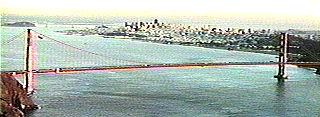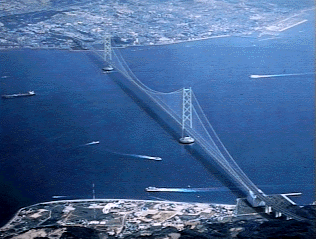


 |
NOTE: All images on this page are clickable. They are linked to more detailed information.
The physics of forces and torques is at the heart of the engineering art and science of building impressive structures. Inventing building materials with specific properties and then putting them together into complicated structures has progressed from baking clay into bricks and building the pyramids to the steel and concrete structures of today, such as the Saint Louis Gateway Arch and the skyscrapers, bridges and domed buildings all over the world.
 What do you see from a distance as you approach a city? In the middle ages the answer was castles, fortresses, and later cathedrals. These were the large structures that greeted the visitors before they could make out the smaller and less conspicuous structures, such as houses.
What do you see from a distance as you approach a city? In the middle ages the answer was castles, fortresses, and later cathedrals. These were the large structures that greeted the visitors before they could make out the smaller and less conspicuous structures, such as houses.
The development of sophisticated building materials and methods gave rise to that twentieth century panorama, the skyline. The 'look' of a city changed. Whether you drive, fly, or sail towards a modern city, what greets you is the city skyline.
For many people around the world New York City's Empire State Building was an still is the epitome of modern architecture. The Empire State Building was build in 14 months between March 1930 and May 1931. For forty-one years it was the tallest building in the world. In 1971 it lost that title to World Trade Center in New York.
The Empire State Building is 1,250 feet tall (excluding the antennas on top) it has a volume of 37 million cubic feet and it occupies a site area of 83, 860 square feet. Indiana limestone and granite cover the frame of the building on the outside, European marble from France, Italy, Belgium and Germany covers the walls of the lobby.
During peak construction periods the building site employed a work force of 3,400 workers and when it was finished it represented seven million man-hours of work. To the amazement of New Yorkers, the building rose from the ground at the rate of 4 and a half stories per week.
In 1971 world tallest building title passed to the World Trade Center in New York. The title got picked up by the Sears Tower in Chicago in 1974. In 1996 the Sears Tower lost the title to Petrona Towers in Kuala Lumpur Malaysia (built by American architect Cesar Pell.)
 The chart on the left represents the history of tall buildings in the US since 1900. The units on the vertical axis are feet.
The chart on the left represents the history of tall buildings in the US since 1900. The units on the vertical axis are feet.
A click on the chart will take to a more detailed site managed by Prof. Jeffery Howe of Boston University.

The idea of a bridge across Golden Gate Straight was conceived by a railroad entrepreneur Charles Crocker in 1877. The idea lay dormant until 1916 when a San Francisco newspaper editor started an editorial campaign which generated a national inquiry among engineers whether such a thing could be built. The majority of the nation's engineers thought that it could not.
A lonely voice was Joseph Baerman Strauss who insisted that the bridge could indeed be build, and for only $25 to $30 million. He also stressed that tolls alone could pay for the bridge.
Strauss faced fierce opposition from special interest groups, such as ferry companies, but he prevailed and on August 11, 1930 he had a permit to contract a 4200-foot main span with a vertical clearance of 220 feet. In the November election the voters approved the bond issue. The construction began in 1933 and the bridge opened to the public on May 27, 1937, six years after the completion of the Empire State Building.
Strauss insisted that the workers be properly protected and the Golden Gate Bridge workers were the first ever to wear a prototype of the hard-hat and protective goggles. They had special diets to fight dizziness and creams to protect their skin against the wind. A safety net was strung under the floor of the bridge. It caught and saved nineteen men who became known as the 'Half-Way-To-Hell-Club'.
Today the 1.7 miles long bridge and the countryside around it are one of the most cherished tourist attractions in the United States, if not the world.

 2.
2. 
 1. One of the most beautiful and impressive large structures in the world is the Saint Louis Gateway Arch, build on the Mississippi river to commemorate the opening of the West.
1. One of the most beautiful and impressive large structures in the world is the Saint Louis Gateway Arch, build on the Mississippi river to commemorate the opening of the West.
The Saint Louis Arch represents a mathematical structure. What structure does it represent?
It is NOT a parabola.
 2. Where is Tacoma? Why did the Tacoma Narrows bridge collapse?
2. Where is Tacoma? Why did the Tacoma Narrows bridge collapse?